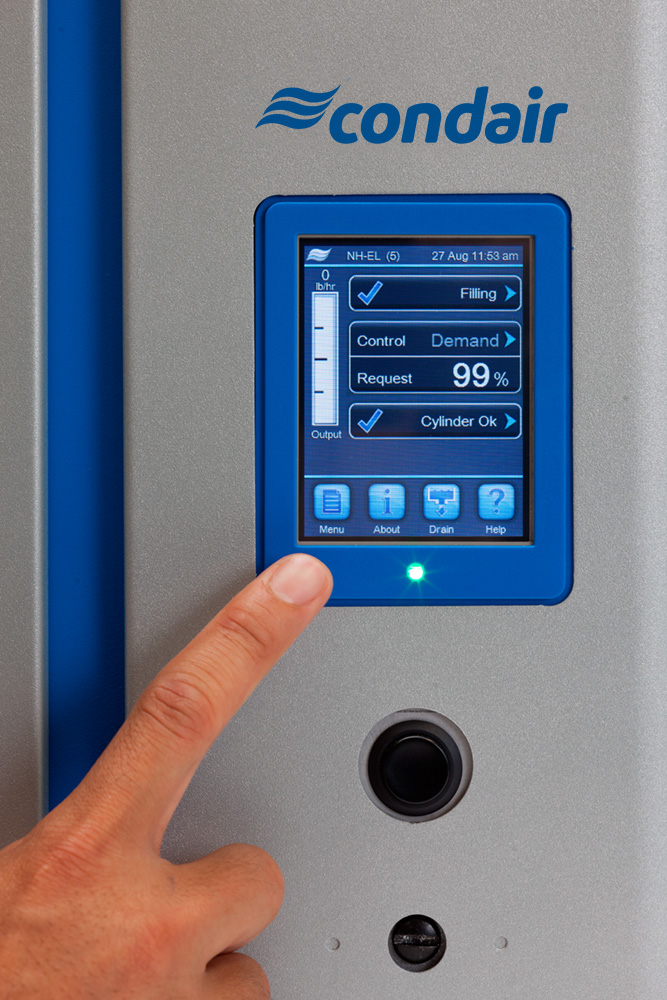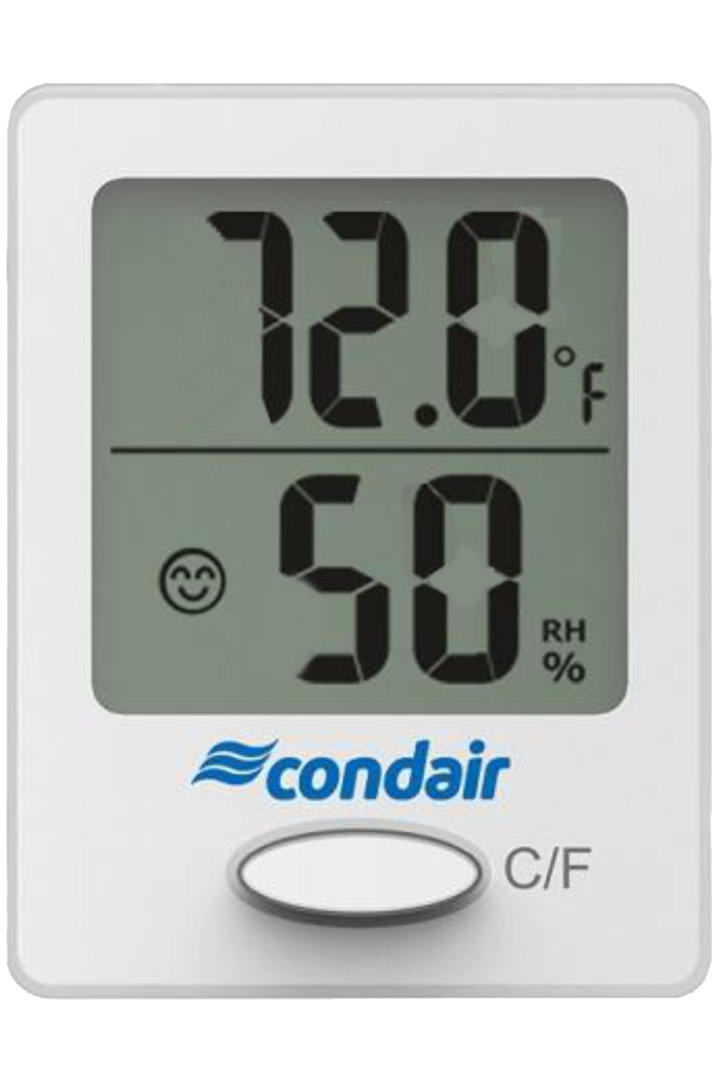Story at a glance:
- Optimal humidity levels reduce absenteeism from respiratory infections and increase employee productivity.
- Condair provides steam humidifiers, in-duct adiabatic humidifiers, direct room spray humidifiers, mobile humidifiers, and more.
- Experts say the 40 to 60% relative humidity range is more pleasant in both cold and warm months.
When Dr. Stephanie Taylor studied the effects of indoor humidity on hospital patients in 2016, she found something startling. Patients in single rooms with low indoor air humidity suffered from “health care–associated infections,” otherwise known as HAIs, to a greater degree than patients in rooms with optimal relative humidity. This matters quite a bit as new infections resulting from exposure to pathogens—including MRSA, E. coli, salmonella, and cytomegalovirus—in hospitals result in 100,000 deaths per year in the US.
The study’s findings are instructive as we emerge from the worst pandemic in a century. The coronavirus that causes Covid-19 is almost entirely transmitted by airborne droplets and aerosols. Since the first outbreaks, the transmission routes of the virus through the indoor environment have been the focus of much study—and will likely inform much of what we think about other airborne-infectious agent transmission for years to come.
Taylor’s study (“Is low indoor humidity a driver for health care–associated infections?,” Indoor Air 2016 conference) correlates other research that finds similar risks from low indoor humidity. Several studies specifically implicate low humidity in disease transmission in workplaces. In purely economic terms, a large study of office employees in Germany from the Federal Institute for Occupational Safety and Health showed an annual loss of about $1,420 US from lost productivity (absenteeism plus under-productivity due to working while impaired by irritation of mucous membranes) per worker per year due to excessively dry office air.
Taylor is an active member of ASHRAE, serving on the Epidemic Task Force, Environmental Health Committee, and as a distinguished lecturer. She is an InciteHealth fellow at Harvard Medical School, president of Building 4 Health, Inc., and a medical advisor to Condair Group, the makers of humidity control devices used in health care, manufacturing, museum, office, residential, and other indoor environments.
Considering the cost of employee illness and absenteeism, employers should be aware that low indoor humidity levels foster respiratory infections among coworkers. The corollary is, of course, the ability to keep employees healthier by maintaining the optimal relative humidity of 40 to 60%.
The Goldilocks Indoor Humidity Zone
- Condair humidifiers provide precise humidity control for workplaces looking to create healthy environments. Photo courtesy of Condair
- Hygrometer. Image courtesy of Condair
Much of this challenges laypersons’ perceptions about indoor humidity. The most common association with humidity management is to employ dehumidifiers to reduce dampness to suppress mold, and to allegedly increase occupant comfort. For generations people relocated to dry desert regions like Arizona to alleviate respiratory problems, and therefore assumed that low indoor humidity is beneficial.
In truth relative humidity—a measurement of the amount of water vapor in air at a given temperature, maintained in the mid-range zone of 40 to 60%—has powerfully protective effects on our health. Conversely, low ambient humidity (less than 40% humidity) creates conditions that are bad for humans. In dry air, exhaled aerosol droplets shrink rapidly and concentrate any infectious microbes contained within. These tiny droplets remain airborne, traveling far and wide while maintaining their infectivity over time and distance. Even worse is the fact that low relative humidity impairs the natural immunity of our airways and skin, weakening the body’s defenses against viruses, bacteria, and fungi.
There is, however, an upper limit to the 40 to 60% Goldilocks humidity range. When humidity is greater than 60% expired droplets shrink less quickly, settling onto surfaces where any contained infectious microbes can be spread through contact routes. The solution to this is to clean surfaces—a much easier task than removing infectious droplets from the air. Another reason to avoid humidity over 60% is that in warm temperatures, people can feel too warm because of decreased cooling from sweat evaporation from skin.
A humidity range of 40 to 60% is the “just right” zone. In this not-too-much, not-too-little range, pathogens are less transmissible and room occupants are less prone to infection. “There are lots of misconceptions around humidity,” explains Marlee Spiegelberg, application engineering manager at Condair USA/CA. “We find that even HVAC specialists need some education on this.”
Fighting Pathogens with Mid-Range Humidity

Photo by Pexels
Spiegelberg details how the building industry’s march toward tighter building envelopes, which laudably enables energy efficiency, also changed the equation on humidity and occupant health. Where caves, grass huts, drafty castles, and humble farmhouses once had lots of atmospheric humidity in them—and less protection from seasonal temperature extremes—today’s inflow of air and humidity are tightly blocked.
In other words, what enables building sustainability isn’t an automatic plus for human health.
So how is the just-right degree of humidity achieved? With the right controls and smart system design, managing humidity with Condair products meets both objectives. The company provides steam humidifiers, in-duct adiabatic humidifiers, direct room spray humidifiers, and mobile humidifiers, among other related products.
Hitting that ideal 40 to 60% humidity range can be achieved in some climates without reducing energy efficiency. In fact, relative humidity affects perceptions of both heat and cooling: In both winter and summer, comfort levels are more easily achieved with the right amount of moisture in the air—lessening the need to ramp up the thermostat up in the winter or the air conditioning in summer.
“The idea that mid-range indoor humidity is a powerful protector of our health is a revolutionary concept for building engineers,” says Taylor. “It’s incredibly exciting that maintaining relative humidity indoors is now being recognized as ‘building medicine.’ Covid-19 has raised awareness of the importance of indoor environments and viral diseases in general.”
But to be clear, every region and every season has unique variables to consider when maintaining healthy indoor humidity levels. Ottawa, Canada (where Condair’s North American operations are based) and Phoenix, Arizona both have dry air, albeit in different seasons and with different outdoor conditions. When Indianapolis hits 87% outdoor relative humidity in summer, air-conditioned buildings many need indoor dehumidification to stay below 60%; Condair offers desiccant dehumidifiers to serve such purposes.
Put Relative Humidity to Work
Increasingly, workplace managers are searching for ways to address worker comfort, productivity, and health. Put Mother Nature to work in the form of healthy indoor relative humidity. The easiest way to measure humidity levels is with a desktop hygrometer, which provides a reading as easily as a thermometer tells the temperature.
Identifying solutions for individual buildings requires assessment of a host of factors. Condair agents are experienced in determining the most cost-effective and low-energy humidification solutions for all building types in all climates.
In addition to protecting human health, the right amount of humidity is necessary for maintaining materials and keeping equipment functioning in a number of industries and applications. Pharmaceutical manufacturing, printing facilities, art museums, and data centers are all affected by relative humidity. Condair products are found in buildings serving all these types of commercial needs and purposes.
The company’s long history of working with commercial applications prepared it for the rising interest in healthy workplaces. In a white paper the company published in 2020, Condair Group CEO Oliver Zimmermann discussed how the company accumulated its expertise. “For years we’ve collaborated with scientists and health care experts to understand and promote the importance of optimal humidity for health,” he says.
“Through this research we appreciate that humidity control is just one, but a decisive, weapon that can be used in the fight against respiratory infections,” Zimmerman adds. It’s certainly nothing to sneeze at.






